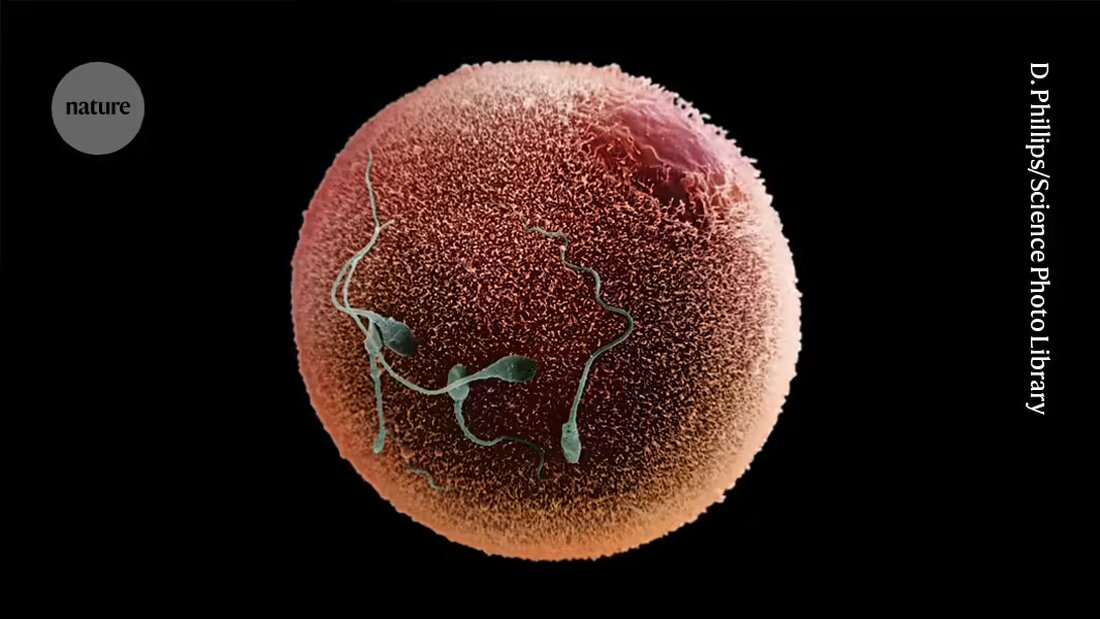AlphaFold shows intimate details of egg and sperm fertilization
AlphaFold reveals how sperm and eggs interact at the molecular level, revolutionizing our understanding of reproduction.

AlphaFold shows intimate details of egg and sperm fertilization
An artificial intelligence tool that won the Nobel Prize this year, has intimate details about the molecular encounter between Sperm and eggs 1 revealed.
The AlphaFold program, that predicts protein structures, identified a trio of proteins that act as intermediaries between gametes. Without these proteins could sexual reproduction stalled in a variety of animals, from zebrafish to mammals.
The one on October 17th inCellThe published finding overturns the earlier assumption that just two proteins - one on the egg and one on the sperm - would be sufficient to ensure fertilization, says Enrica Bianchi, a reproductive biologist at the University of Rome "Tor Vergata" who was not involved in the study. "It's no longer the old concept of having a key and a lock to open the door," she says. “It’s gotten more complicated.”
A mysterious union
Despite its critical role in reproduction, egg-sperm fusion in vertebrates is a molecular puzzle that has proven difficult to decipher. The connection between the two cells contains proteins that are located in fatty membranes and are difficult to examine using common biochemical methods. The interactions between these proteins are often weak and volatile, and it is difficult to collect enough eggs and sperm from some of the favorite laboratory animals, including mice, for large-scale experiments.
For this reason, early studies of reproductive biology often focused on marine invertebrates, which release large quantities of eggs and sperm into the water. “If you take a textbook and look up fertilization, you'll be all over it sea urchin "It's a tricky thing to study," says Gavin Wright, a biochemist at the University of York, UK, who was not involved in the study.
To overcome the supply problem, Andrea Pauli, a molecular biologist at the Research Institute for Molecular Pathology in Vienna, and her colleagues began their work Zebrafish, a type of vertebrate that also releases its eggs and sperm into the surrounding water. To circumvent the difficulties of working with membrane proteins in the laboratory, the team used AlphaFold to predict the interactions between proteins. Two of AlphaFold's developers received the Nobel Prize in Chemistry on October 9th.
Not two, but three
AlphaFold predicted that three sperm proteins work together to form a complex. Two of these proteins were previously known to be important for fertility. Pauli and her colleagues then confirmed that the third is also crucial for fertility in both zebrafish and mice and that the three proteins interact with each other.
The team also found that in zebrafish, the trio creates a place for an egg protein to bind, providing a mechanism by which the two cells can recognize each other. "It's a way of saying, 'Sperm, you found an egg' and 'Egg, you found a sperm,'" says Andreas Blaha, a biochemist at the Research Institute of Molecular Pathology and co-author of the study.
The results could one day provide a way to screen people with infertility to see if problems with this complex could be the cause, says Wright.
The results also highlight AlphaFold's role in studying fertilization, he adds. “We are limited in terms of experimentation,” he says. “It could be that these model results play an important role in the future.”
-
Deneke, V.E., et al. Cell https://www.cell.com/cell/fulltext/S0092-8674(24)01093-6 (2024).

 Suche
Suche
 Mein Konto
Mein Konto
